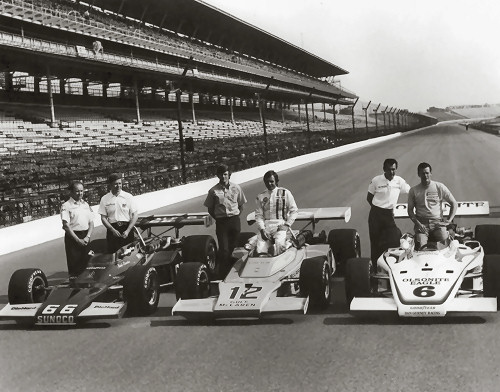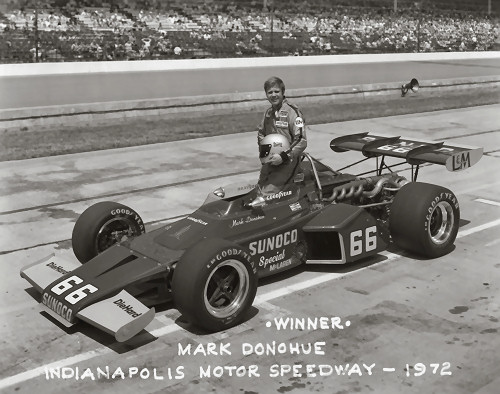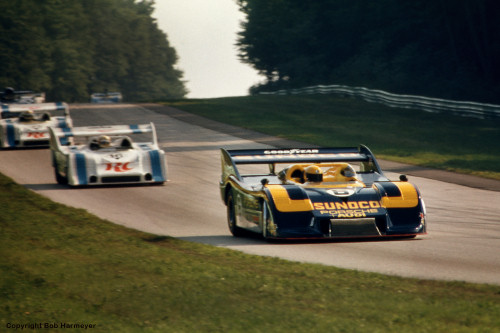The Way It Is/ Penske Racing's formative yearsby Gordon Kirby |
 This week, a Christmas tale about the creation of Penske Racing. Roger Penske's IndyCar team is the most successful in the history of American open-wheel racing, of course, with 15 Indy 500 victories, 165 USAC/CART/IRL/IndyCar wins, 211 poles and 12 championships. In all, Roger's race teams have won 23 national championships, including this year's NASCAR Sprint Cup title with Brad Keselowski.
This week, a Christmas tale about the creation of Penske Racing. Roger Penske's IndyCar team is the most successful in the history of American open-wheel racing, of course, with 15 Indy 500 victories, 165 USAC/CART/IRL/IndyCar wins, 211 poles and 12 championships. In all, Roger's race teams have won 23 national championships, including this year's NASCAR Sprint Cup title with Brad Keselowski.
Today, Penske's NASCAR and IndyCar teams are run out of a giant operation sprawling across 105 acres and employing 400 people in Mooresville, North Carolina. But when Roger started his race team back in 1966, it occupied a tiny, single-car garage in Newtown Square, Pennsylvania, and there was but one employee, Karl Kainhofer. Penske started racing in 1958 during his college days and hired Kainhofer a couple of years later on a part-time basis to take care of his Porsche RS60. Roger moved on to race a Cooper Monaco and the famous Zerex Special before driving John Mecom's Can-Am car in 1963 and Jim Hall's Chaparrals in '64. At the end of that year Penske retired from driving to concentrate on founding and building his business empire, Penske Corporation, which today employs more than 36,000 people in 1,800 locations around the world and generates revenues of more than US$16 billion.  © Racemaker "We went to Mecom's place in Texas and bought a Lola T70 rolling chassis from him," Kainhofer says. "That's how we started. It was just a car without a motor, or a driver, or anything, and a shop like a shoebox. We had a one-car garage with one workbench and a pay phone." A few weeks later Penske hired Mark Donohue to drive and Donohue won three races that year--a USRRC race at Kent, Washington in July; round three of the inaugural Can-Am series at Mosport in September; and the Tourist Trophy at Nassau in December. The following year Donohue and Penske won the USRRC title and they also raced in the Can-Am and Trans-Am series. In 1968 Donohue repeated as USRRC champion, won the Trans-Am title and finished third in the Can-Am behind the factory McLarens. Penske also made his first move into Indy cars in '68 with Donohue racing an Eagle-Chevy in a pair of USAC road races at Mosport and Riverside. "In those days we raced two or three different types of cars," Kainhofer recalls. "It seemed like we were doing something different every day. In '68, there were just six or seven guys working on the Camaro Trans-Am cars, the McLaren Can-Am car and the Eagle Indy car." Penske started 1969 by winning the Daytona 24 Hours with Donohue and Chuck Parsons driving a Lola-Chevy T70 coupe. Yet again Donohue won the Trans-Am championship in '69 and also made his and Penske's rookie start at Indianapolis. Aboard a turbo Offy-powered Lola T152 Donohue qualified fourth and was battling Dan Gurney for second in the race when the magneto failed. After a pitstop for repairs Donohue finished seventh, taking the 500's 'rookie of the year' honors. In 1970, Penske's primary effort went into running a pair of AMC Javelins in the Trans-Am series for Donohue and Peter Revson. At Indianapolis Donohue raced a 4WD Lola-turbo Ford, finishing second to Al Unser with Dan Gurney third. Donohue ran three other USAC races that year and also raced a Lola-Chevy in three SCCA Formula 5000 races, winning at Mosport and Sebring. In '71 Donohue's plate was extremely full. He won Penske's third Trans-Am championship, this time for American Motors; co-drove Penske's Ferrari 512M with David Hobbs at Daytona, Sebring, Le Mans and Watkins Glen; ran the Canadian and United States GPs in a Penske-prepared McLaren M19, finishing third in his F1 debut at Mosport; raced an F5000 Lola in the Questor Grand Prix in California; and ran nine USAC Championship races, Indy 500 included. Penske and Donohue switched to McLaren's new wedge-shaped M16 Indy car in '71 and Donohue scored Penske's first Indy car win in the Pocono 500 in July and also won a 200-mile race at Michigan two weeks later. Comments Penske: "Through our long-standing relationship with Bruce (McLaren), Teddy Mayer, and Tyler Alexander, Mark and I were impressed with their new design incorporating aerodynamic advances which we decided was what we needed to be competitive, especially at Indianapolis.  © Racemaker But at Indianapolis, Donohue was out of luck after setting the pace through practice and leading the race's opening 50 laps. "In '71 with the McLaren we were the fastest car all month long, except that Peter Revson beat us on qualifying day," Kainhofer recalls. "In those days you could play so much with the Offy. You could crank boost in and out and we could run 1,100 horsepower for qualifying. It was somewhere around 850-900 for the race. In qualifying Mark had a little bit too much oversteer, so just before he went out to qualify he had me take some boost out and we lost the pole to Revson. They cranked a little more boost in and got us by a little bit." Still, Donohue was the man to beat on raceday. "We led most of the first 66 laps and then the top gear broke," Kainhofer says. "That was one of the things that was out of our hands in those days. They had new gears made because there was a problem but they used the wrong material. They found that out later. "That was a beautiful car," Kainhofer adds. "I think that was one of the nicest cars ever. After that the cars got bulkier and the wings got up in the air and they got kinda chunky looking. But in '71 it had that low wing and was a very slim car, just a nice-looking car." For 1972 Penske fielded a new NASCAR operation running AMC Matadors and a new Can-Am team devoted to racing Porsche's mighty Porsche 917/10. For his Indy car team Penske hired Gary Bettenhausen to partner Donohue. Bettenhausen was the oldest son of 1951 and '58 Indy car champion Tony Bettenhausen and had won the USAC Sprint car championship in 1969 and '71. Bettenhausen made his rookie start at Indianapolis in 1968 and immediately showed what he could do with Penske, winning the second race of the '72 USAC season in April at Trenton aboard one of Penske's new McLaren M16Bs. "Gary was one of the most aggressive drivers at that time," Penske remarks. "He had great car control developed through his experience with the USAC sprints and midgets. He was willing to work closely with Mark on development of the Indy cars and was always up on the wheel in the races."  © Racemaker "With the rules package at that time," Penske observes, "there was opportunity for considerable development happening on all fronts--engines, chassis designs, aerodynamics and tires. It was very challenging to develop the most competitive package you could, which Mark and I spent a lot of time sorting out. There was a lot of manufacturer and sponsor involvement and it was great racing among great teams and drivers. And I think it built the fan interest in Indy car racing, especially at Indianapolis where we had great crowds all month." Unser led the opening laps of the '72 500 before dropping out with a broken ignition rotor. Bettenhausen then took over the lead chased by Donohue and Jerry Grant in AAR's second Eagle. For most of the distance Bettenhausen appeared to have the race in the bag, leading 138 laps before he was stopped by a magneto problem. "Bettenhausen was running just a little bit better than Mark in the race," Kainhofer recalls. "The cars were very similar. I don't think Mark would have wanted it any other way. Gary was a good oval racer. He was a very good race driver." Bettenhausen missed the last four races of '72 after breaking an arm in a sprint car accident in August. He went on to win the Texas USAC race for Penske in October of '73 but in July of '74 he was more seriously injured after flipping a sprint car. That was the end of the road for Bettenhausen with Penske although he continued to race Indy cars through 1993. After Bettenhausen dropped out at Indy in '72 Jerry Grant took the lead for a handful of laps but Grant was struggling physically with a weak neck, then pulled in for a splash of fuel taken illegally from teammate Unser's refuelling rig so that USAC didn't score Grant's final twelve laps. Meanwhile, Donohue took the lead and drove home to beat Al Unser by more than a lap. "With his engineering background and racing experience, Mark always took a very analytical approach to setting up the cars," Penske comments. "He always considered every variable and worked through them when he tested the cars to achieve the most competitive set-up he was comfortable with driving. He loved to test and was one of Goodyear's favorite test drivers based on the comprehensive feedback he could communicate for their tire development. His focus was not just on having the fastest car but also the best race set-up over long runs, as his performance record verified. "At Indy in '72, Mark drove a steady pace all day adapting the set-up to the track as it changed. Karl and the crew did a great job on our pit stops and when the window of opportunity opened late in the race Mark had the car set-up just the way he wanted it and was ready to go." Kainhofer says it was all about the proper preparation. "That was always our key from the first day I worked with Roger right through to the end," Kainhofer remarks. "Preparation was always our number one thing to try to prepare better than the next guy. That's what got us a lot of wins. Sometimes you out-prepare yourself and lose that way. But in '72, all I can say is we got lucky."  © Bob Harmeyer "Roger had this three-year program," Kainhofer grins. "We were going to try to win it in three years and we almost did. But we did it in the fourth year." Three weeks after winning the Indy 500 Donohue crashed while testing Penske's Porsche 917/10 Can-Am at Road Atlanta when the rear bodywork broke loose while Donohue was in the fastest section of the track. The 917/10 hit the bank hard, cartwheeled down the road and comprehensively destroyed itself. Donohue was lucky to escape with nothing worse than a broken left leg, but he was out of action for a couple of months. George Follmer replaced Donohue in the Can-Am Porsche and went on to win the championship. Donohue returned to action for the year's last four races in a second Penske 917/10 and won at Edmonton after Follmer had to stop to replace a punctured tire. In 1973 Donohue concentrated on the Can-Am series with the amazing Porsche 917/30K. He was on the pole at every race and won six of eight Can-Am races on the way to the championship aboard one of the most remarkable racing cars of all-time. Donohue also ran the SCCA's Formula 5000 series in a Lola with an underpowered and unreliable AMC engine and competed in only two USAC races--the Indy and California 500s--but didn't finish either one because of engine failures. At the end of 1973 Donohue won two of the first three IROC races run at Riverside before wrapping-up the inaugural IROC championship on the road course at Daytona in February of '74. Donohue then announced his retirement but he was unhappy out of the cockpit working as team manager and came back in September to debut Penske's new F1 car at the Canadian and United States GPs. "I was the first guy to actually test the car on the skid pad at Reading," Kainhofer says. "At the time we didn't have a driver but then Mark said he was going to test it and see what it looked like. After a couple of tests he said, 'Well, if I tested it, I might as well race it.'." In 1975, Donohue ran the full F1 World Championship schedule, but the Penske PC1 was off the pace and was replaced late in the year by a March 751. At the third race with the March at the Osterreichring in August Donohue`lost his life after crashing in the morning warm-up. As always, Karl Kainhofer was working as Donohue's chief mechanic that sad day. "In the ten years Mark drove for Roger I was with him basically where ever he went," Kainhofer remarks. "Mark died in my hometown in Grasz in Austria." At the end of the year Kainhofer returned to the United States to organize a new engine shop for Penske. Thereafter he ran the engine shop, building Penske's Indy car engines through his retirement in September of 1997.  © Bob Harmeyer Penske's second Indy win didn't come until 1979 with Rick Mears followed in rapid order by a skein of 500 victories with Bobby Unser in 1981, Mears again in '84, Danny Sullivan in '85, Al Unser in '87, Mears again in '88 and '91, Emerson Fittipaldi in '93, Al Unser Jr. in '94, Helio Castroneves in 2001 and '02, Gil de Ferran in '03, Sam Hornish in '06 and Castroneves again in '09. Kainhofer commented on what he believes made Penske so successful. "Roger understood from day one that you cannot be successful without having the best car if you can have it," he observed. "He was always looking for the best car and obviously he was looking for the best people. That's the combination you need. "And the other thing is we always strived to look better than the next guy. I did that from day one and that's what Roger wanted too. We went to an SCCA National race at Pensacola, Florida in February, 1960 and I got a little trophy for 'best overall appearance'. We always wanted to look good and we always wanted to run all day. He and I always had the same philosophy. I wanted my car looking better underneath than anybody else's, but we worked hard at it. "We weren't always the fastest but we tried to run all day. That was Roger's thing from day one. People would give him money to put into race cars because he had a good-looking car, and of course, he tried to perform well. That was his edge from day one." Looking back on his epic career as a team owner and businessman Penske says Donohue set the standard for his team and business empire. "Mark and I worked closely together on planning all of our programs and we were fortunate to have dedicated, talented people on the team," Penske remarked. "We had a small, core group of mechanics and fabricators who handled the preparation of the cars and colleagues who came in on weekends to fill out our pit crews. It was a considerably smaller group than the specialists we have today on the team. "As chronicled in many articles and books Mark's dedication to Penske Racing was legendary. He had a ten-tenths commitment to the team and our programs. He set a great work ethic example with our people on the day-to-day operations and what it took to get the job done. "There was no job too big or too small in his eyes," Penske added. "After the crew worked several straight days to prepare the Ferrari for Sebring in '71 for example, he insisted on driving the transporter from Newtown Square, PA to the track! While we worked together closely on all fronts to achieve our goals, the record book is testament to his contribution." Penske Racing's foundation was built on the shoulders of Mark Donohue and Karl Kainhofer, two genuinely remarkable men from a very different era. *I'm taking a holiday break from writing this column through the next three weeks. I'll return on January 14th. My best wishes to all for a happy and hospitable Christmas and New Year's season. |
Auto Racing ~ Gordon Kirby Copyright 2012 ~ All Rights Reserved |
